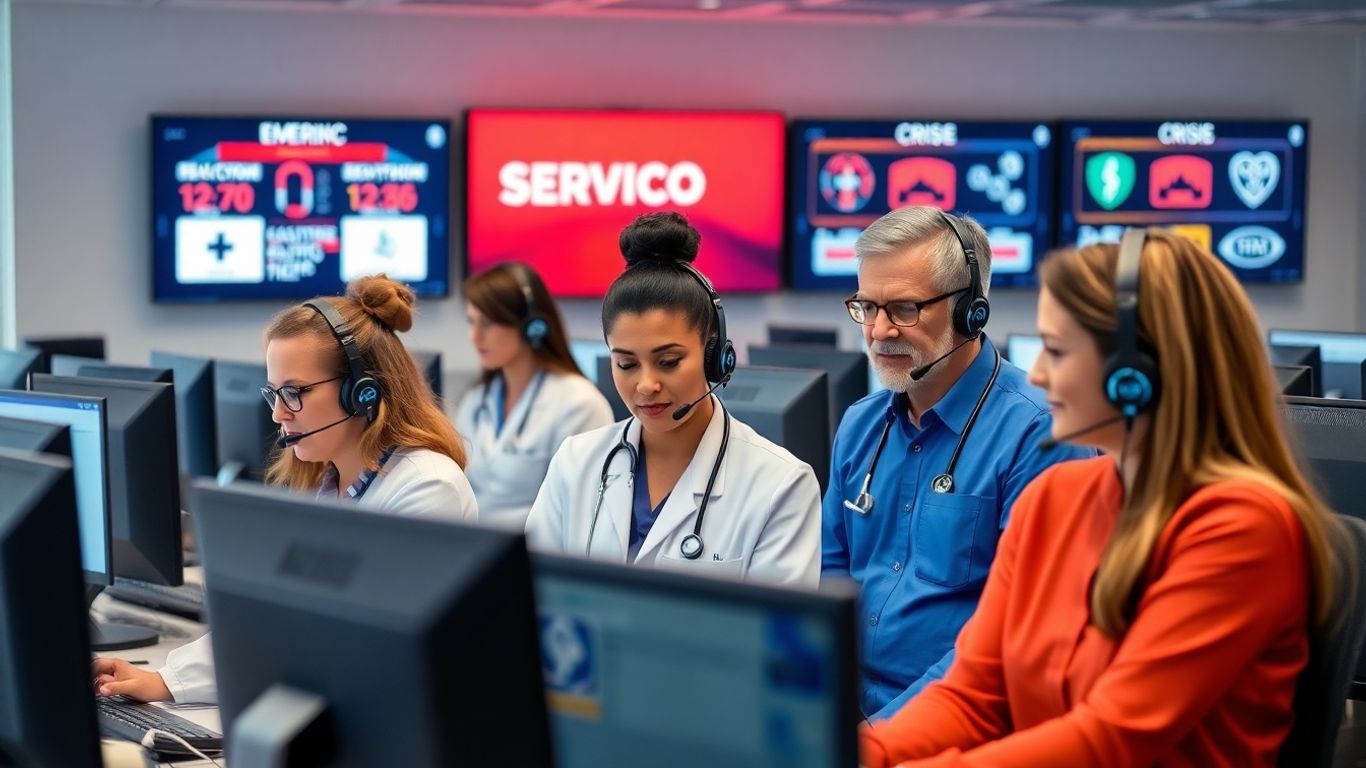Healthcare in the U.S. is changing fast, especially when it comes to how patients and providers stay in touch. Medical call center services in USA are now doing way more than just answering phones—they’re helping people book appointments, get reminders, and even talk to a nurse after hours. With new tech like AI and smart scheduling, these call centers are a big part of making sure patients get help when they need it, no matter what time it is. If you run a clinic or a hospital, or if you’re just someone who’s ever waited on hold for a doctor, you’ll want to know why these services matter so much in 2025.
America’s medical call centers aren’t what they used to be. Heading into 2025, these hubs have shifted way beyond simple message-taking or transferring calls. They now orchestrate care across entire patient journeys, act as proactive health advisors, and give healthcare teams more breathing room.
A decade ago, a typical call center just took messages or set basic appointments. That’s no longer enough. Today, medical call centers:
Healthcare providers are finding that coordinated call center support actually reduces ER visits and unnecessary readmissions by keeping patients connected to the right care.
These call centers support large-scale outreach now. They aren’t passive; they’re:
Initiatives aren’t just about robocalls—teams use sophisticated scripts and digital records to tailor every message. Personalized support keeps patients feeling valued, leading to higher engagement and follow-through rates.
Demand keeps rising. Providers can’t always afford an army of front-desk staff, especially after-hours. Here’s what’s changing in 2025:
These trends equal a big win for both sides. For patients, it’s easier to access care, get clear answers, and never feel lost in the system. For healthcare teams, smarter call centers mean less burnout and better results—without breaking the bank.
Medical call centers have redefined how patients connect with healthcare. By guaranteeing uninterrupted access to assistance, these services remove hurdles that once kept care out of reach, especially after hours. Let's explore what round-the-clock service really means for modern healthcare.
Gone are the days when a patient’s only option outside business hours was the emergency room. Now, patients can reach knowledgeable staff via phone or even SMS any time of day. This immediate connection helps with:
Even when traditional clinics are closed, call center agents—supported by smart tech—keep the healthcare wheels turning. With tools like AI-driven 24/7 customer support, meeting modern expectations for instant care is now practical and affordable.
Many patients struggle to access care due to work schedules, transportation, or language barriers. A 24/7 call center flattens these obstacles by offering:
Today’s patients expect help when they need it—not just during the 9-to-5 grind. With continuous coverage, healthcare organizations can:
Knowing that help is available at any time builds real confidence in healthcare providers and encourages people to seek necessary care without hesitation.
It’s clear that 24/7 medical call centers don’t just fill in the gaps—they’re shaping the new baseline for accessible, responsive healthcare in 2025.
Reaching patients in 2025 isn't a one-size-fits-all task—patients want to interact in the way that feels most comfortable and convenient for them. This means that medical call center services must offer phone, text, and digital options, all working together to make healthcare access simple and personal.
Today's patient expects flexibility. Phone calls are still common, but more folks are sending texts or wanting to use web chat and secure messaging apps. A true omnichannel setup lets people swap between these without ever feeling like they've lost their place. Maybe you start a conversation about an appointment in a chat, confirm it by phone, and get a reminder by SMS—it's all logged in one system so no one repeats themselves.
Giving patients options helps everyone feel more in control and makes it less likely that important stuff slips through the cracks.
Jumping from one platform to another can frustrate patients if the experience feels disjointed. To avoid that, it's important that each interaction:[e71d]
Here's a snapshot of how consistency impacts satisfaction:
Personalization isn't about using a name in an email—it's tracking preferences, needs, and habits, and then shaping the communication accordingly. For example, if you know a patient prefers texting for reminders but calls for test results, your system should adapt automatically. Good personalization builds trust, especially if patients feel respected, informed, and not just like another case number. A little human touch, like explaining procedures clearly or checking in after a visit, goes a long way to improving patient satisfaction.
If patients feel like their needs are being anticipated, they're more likely to engage with upcoming appointments, follow through on care, and feel positive about the whole healthcare experience.
Organizing healthcare appointments in 2025 isn’t about just filling up the calendar—it’s about making sure every patient can find a time slot that works, gets the right prompts, and feels taken care of from first call to follow-up. Medical call center services in the USA are driving this change, blending human touch with smart automation to solve everyday headaches for clinics and patients alike.
Most healthcare offices have grown tired of phone tag. Modern call center platforms now plug directly into scheduling tools, letting staff and patients see real-time openings. No more double booking or hold music nightmares. If you're looking to make dental visits easier, choosing clinics that offer efficient, tech-enabled scheduling can cut back on waiting and confusion (practical scheduling tips).
Key benefits include:
No one likes to get ten reminder calls at weird hours. Today’s AI-powered systems know when to call, text, or email—often at times patients actually prefer. These reminders don’t just nudge about the schedule; they answer prep questions, give directions, and capture last-minute changes. AI can even answer follow-ups, cancel slots, or switch times instantly when a patient sends a quick text.
Main features:
Fewer no-shows can mean thousands of dollars and hours saved for every medical provider. Call centers help keep missing appointments low by sending gentle reminders and making it simple for patients to update their status. Plus, they can fill canceled slots fast—sometimes contacting patients on waitlists within minutes after a spot opens.
Here’s a quick snapshot of how effective reminders change the numbers:
Keeping appointment workflows smooth helps both clinics and patients. With smart call center services, offices waste less time on the phone, and patients are much less likely to be left in the dark—which feels a whole lot better for everyone.
Artificial intelligence and automation are changing medical call centers in the US. Not every improvement grabs headlines, but the daily impact is real. With so many calls and requests, older systems can’t keep up. Today’s AI tools answer calls at all hours, manage questions, and help healthcare teams work smarter—not harder.
Modern medical call centers use conversational AI that can actually hold a decent, useful conversation. It’s not just about picking up the phone; these systems understand context, figure out what the person needs, and respond in a natural way. For example, advanced AI receptionist services now reply instantly through both calls and texts, mimicking the feel of a real person. They sort simple things (like appointment requests or billing questions) and pass along the tough stuff to human agents. Patients don’t get stuck in endless menus. In fact, one big win is less wait time—people get answers quicker and spend less time on hold.
AI call handling frees up human agents for urgent or complex problems, making patient care faster and more personal. That shift means small clinics and big hospitals alike can focus on what really matters: patient health.
With all the calls coming in, knowing what to expect is key. Predictive analytics looks at patterns (think: cold and flu season or sudden local events) and helps call centers figure out when call spikes will hit. This isn’t guesswork—it’s data.
By forecasting busy hours, staffing needs get balanced and doctors’ time is used better. AI flags repeat issues or high-risk trends, so managers can fix problems before they grow.
Speed matters. Patients used to wait for a callback, or worse, they’d give up trying. Today, call centers deliver info instantly—voice and SMS, sometimes during the call itself. Picture this: a new patient calls about hours, and the AI texts a map and directions without missing a beat. Or the system sends appointment reminders and prescription notes via SMS, cutting down on missed visits and confusion.
For many healthcare providers, switching to AI-powered systems wasn’t a luxury—it was a survival move. The ability to answer questions day or night, automate scheduling, and track patient preferences keeps practices competitive and patients happier than ever.
Medical call center automation isn’t just a tech upgrade; it’s a practical way to run modern healthcare in 2025. If your team still does everything by hand, it might be time to see how AI front desk services lighten the load and improve patient care.

Disaster situations and public health emergencies can overwhelm healthcare resources and disrupt normal communication. In these moments, medical call centers are far more than a convenience—they transform into the nerves of the healthcare system. With their ability to ramp up support instantly and maintain clear lines of communication, medical call centers hold healthcare together when it matters most.
When a crisis hits—whether that’s a pandemic, wildfire, or hurricane—the volume of patient calls and urgent inquiries surges. Medical call centers are structured to adapt quickly:
Even when uncertainty is everywhere, a strong medical contact center can keep patients informed and connected to timely care, reducing panic and misinformation.
Effective disaster management means prioritizing who needs help first. During outbreaks (like in the COVID-19 era), call centers were vital for:
These services not only manage surge capacity—they help prevent ERs from being flooded by people who could be helped over the phone or scheduled for telehealth instead.
Whether the threat is a flood, earthquake, or blizzard, care doesn’t pause for bad weather. Medical call centers support the healthcare ecosystem by:
Centers with geographically distributed teams and robust digital platforms, like those provided by AI-powered phone service companies, are especially resilient—they keep working when local infrastructure is hit.
In the aftermath, these centers often help with:
Key Takeaways:
It’s nearly 2025, and data breaches in healthcare still make the news far too often. When it comes to medical call center services in the USA, nothing matters more than keeping patient information safe and complying with a web of regulations.
Protecting patient health information is not optional—it's the foundation of any reputable medical call center. These centers have to meet the requirements of HIPAA (Health Insurance Portability and Accountability Act), and that's only the start. Many also need to prove compliance with HITECH, which increases penalties for data violations, and DEA rules if they handle prescription information. Plus, if they're working with international patients, things like GDPR might come up.
Key compliance steps include:
Handling sensitive info isn't as simple as just locking it behind a password. Medical call centers use multiple layers of security:
A single lapse could lead to stolen records, fines, and loss of trust that takes years to rebuild.
In a world where patient trust is easily lost, even one data breach can damage a healthcare provider’s reputation for years. Patients want honest answers about how their records are protected and who is responsible.
Passwords alone just don’t cut it nowadays. Most call centers are moving to:
These methods cut down on unauthorized access and help build a reliable audit trail in case of concerns or investigations.
Bottom line: any call center touching healthcare data needs serious policies, up-to-date tech safeguards, and a willingness to adapt as threats change. If you’re picking a vendor, double-check their security and compliance measures—your patients (and your bottom line) are on the line.

In today’s healthcare world—even in 2025—the old one-size-fits-all approach just doesn’t cut it. Medical call centers have to do more than answer calls in English; they need to meet people where they are, speaking their language in every sense. Multilingual and culturally competent communication isn’t just about translation—it’s about trust and outcomes.
America is a patchwork of backgrounds and languages. If a patient can’t explain their symptoms or follow healthcare advice due to a language gap, their care suffers. Modern medical call centers support:
Recent research showed patients with language-matched agents see up to 28% higher rates of following care instructions. Call centers with non-English language support, like advanced multilingual AI receptionists, help bridge this gap efficiently and cost-effectively.
It’s not just language. How people talk about health is wildly shaped by culture, tradition, and comfort level. That’s why agents receive:
Blockquote:
Good communication isn’t just about the words you choose—it’s about knowing when to listen, how to pause, and what makes patients feel safe enough to talk.
The scale of multilingual service would be impossible without powerful AI tools. Here’s how new tech is working in medical call centers:
On top of that, advanced call centers offer workflow automation in multiple languages, so scheduling and information delivery happen seamlessly for anyone. As more organizations recognize how diverse patient needs are, these tools aren’t a luxury—they’re the baseline.
Multilingual and culturally aware call centers are reshaping what inclusive healthcare means. It’s not just about being understood. It’s about making everyone feel like they actually matter, every time they reach out for help.

Making sure agents are ready for every type of medical call isn’t a one-and-done checklist—it's an ongoing job.
Before speaking to patients, most call center agents must complete healthcare-focused training. The basics? Medical terms, recognizing urgent health problems, following privacy rules (think HIPAA), and understanding when to escalate calls fast. This isn’t just memorizing a glossary; agents have to pass structured certification that covers patient safety and privacy. These programs often update regularly, since medical info and rules don’t stand still.
Just finishing a training isn’t enough—call center leadership keeps an eye on performance daily.
Here’s how it usually works:
A call center with strong feedback cycles often sees better patient experiences and fewer complaints. One option for real-time monitoring is to use integrated analytics platforms, similar to what's offered by AI Phone Receptionist services, which help spot patterns quickly.
Relying just on human supervisors to catch all quality issues isn’t realistic. More and more, AI is stepping in to help. AI quality monitors can scan every call, not just random samples—looking for critical phrases, privacy breaches, or missed escalation cues.
AI can process massive call volumes, then flag any interaction that needs a human to dig deeper. This creates a safety net, not just for legal compliance but also for making sure agents handle patients with care.
Patients quickly notice when agent quality slips—even a small drop can impact their trust. That’s why real commitment to training and consistent quality checking sets apart the best medical call centers.
Staff training and smart quality control are never set-and-forget. Medical call centers that invest in a good mix of expert coaching, trusted certification, and real-time feedback—often augmented with next-gen tools—are the ones who consistently keep patients safe and happy.
Medical call centers have stepped into a new role as proactive partners in population health by reaching out to patients with chronic illnesses. Regular touchpoints—like scheduled check-ins and medication reminders—keep patients on track with their care plans, helping to spot problems early. Instead of waiting for issues to develop, care coordinators use outbound calls and personalized messages to provide:
This kind of outreach, using structured communication, has proven to cut down emergency visits and avoidable readmissions. For example, implementing chronic care call programs among high-risk patients can lead to measurable improvements:
Staying connected with patients builds trust and helps prevent their conditions from spiraling out of control, which saves money and improves quality of life.
One of the hardest parts of managing a population's health is making sure people actually take their medication as prescribed. Call centers address this by:
Sometimes, a quick call or text nudge can make all the difference. Improved medication adherence has a direct impact on lower hospitalizations and better overall results for patients.
Call centers also shine when it comes to getting the word out about preventive care initiatives. Flu shot reminders, annual wellness campaigns, and health education notices help close the gap for patients who may slip through the cracks during busy clinic seasons. These teams can personalize outreach based on patient history and encourage participation in:
Modern engagement strategies even emphasize the importance of patient education and long-term relationships, which is key in improving treatment acceptance and preventive behaviors.
When patients feel supported, informed, and regularly checked in on, they're more likely to stay engaged in their own health.
Meeting patient expectations and keeping up with rising demands can push any healthcare provider—whether solo practice, midsize clinic, or sprawling hospital network—to the brink. Flexibility and control over cost and communication are non-negotiable now, and medical call center services have caught up. Scalable solutions are reshaping how providers across all sizes manage patient communication, boost efficiency, and control expenses.
Blockquote:
Some providers get so buried in administrative calls that patient care takes a back seat. With scalable call center solutions in place, they often reclaim dozens of clinical hours weekly while improving how fast and reliably they connect with patients.
Scalability isn't about fitting into one rigid system—it's about matching service to your practice's needs today, then shifting easily as things change. Big or small, local or national, healthcare providers can keep the lines open and the bottom line in check.

As telehealth adoption hits new highs in 2025, medical call centers play a bigger role in making sure patients and providers actually connect whenever and however they need. Virtual care isn’t just video calls; it’s a network of people, technology, and workflows that demand tight coordination. Medical call centers are often the hidden force holding it all together.
One of the main challenges in virtual care is scheduling. Between busy provider calendars, multiple platforms, and patients of all tech abilities, it’s rarely simple. The best medical call centers can:
Here’s a quick table that shows how dedicated telehealth support stacks up against regular staff in appointment success:
(Stats reflect typical results seen by organizations focused on telehealth care coordination.)
Medical call centers don’t stop at scheduling. Many now help with:
All this happens while keeping data secure through patient-approved channels, something modern call centers like My AI Front Desk’s affordable plans prioritize by design.
It’s pretty common for a patient to start with a virtual consult, but then get sent in for labs or a hands-on exam. The call center agent can:
Virtual care transitions are less about technology, more about getting the basics right: clear communication, time-saving coordination, and making sure patients never feel lost between clicks and clinic doors.
Plus, modern platforms allow multi-channel support—patients can call, text, or even interact with advanced automated systems like Front Desk's AI-powered receptionist for questions or scheduling around the clock.
These high-touch, tech-smart medical call centers help keep things connected, whether it’s laptops, smart monitors, or a real person’s voice on the other end. In 2025, telehealth is only as reliable as the team behind the scenes making sure every patient gets the care they need, no matter the platform or place.
Virtual care and telehealth are growing fast, making it easier for doctors and patients to connect from anywhere. Our tools help healthcare teams talk to patients, set up appointments, and answer calls 24/7. Want to see how simple it can be? Visit our site today to learn more and take the first step toward easier virtual care.
So, here’s the bottom line: medical call center services in the USA aren’t just a nice-to-have anymore—they’re a must for modern healthcare in 2025. With patients expecting quick answers and round-the-clock support, these call centers fill in the gaps that busy clinics and hospitals just can’t cover on their own. Whether it’s scheduling appointments, answering questions, or handling emergencies at 3 AM, the right call center keeps everything running smoothly. Plus, with new tech like AI receptionists and smarter data sharing, things are only getting faster and more reliable. In a world where every minute counts and nobody wants to be put on hold, having a solid medical call center isn’t just smart—it’s how you stay ahead. If you’re still relying on old-school systems, you’re probably missing out on happier patients and a more efficient practice. Maybe it’s time to give these services a real look.
A medical call center service is a team or system that helps healthcare providers handle patient phone calls, schedule appointments, answer questions, and give information about care. These centers can use real people, AI, or both to make sure patients get help quickly.
Medical call centers are important because they help patients get answers and support any time, day or night. In 2025, people expect fast, easy service. Call centers make sure no one has to wait too long or leave a message and hope for a call back.
Medical call centers can handle urgent calls after hours or during disasters. They can provide quick advice, connect patients to doctors, or help with triage to decide who needs care fastest. This helps hospitals and doctors focus on the most serious cases.
Yes, many medical call centers offer help in several languages. They hire staff who speak different languages or use technology like AI to translate. This helps everyone get the care and answers they need, no matter what language they speak.
Medical call centers use strong data security to protect your private health information. They follow strict rules, like HIPAA, to make sure your details are safe and only shared with people who need to know.
Call centers make it easy to book, change, or cancel appointments. Some use AI to send reminders by text or phone, which helps people remember their visits and reduces missed appointments.
Modern medical call centers can handle lots of calls at the same time using special technology. This means you’re less likely to hear a busy signal or wait on hold for a long time, even during busy periods.
Yes, medical call centers offer plans for all sizes of clinics, from small offices to big hospitals. They can be customized to fit the needs and budget of each healthcare provider, so even small clinics can give great service to their patients.
Start your free trial for My AI Front Desk today, it takes minutes to setup!








